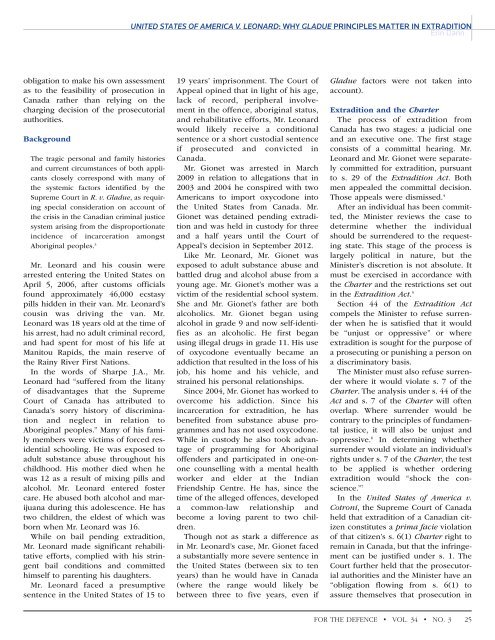FTD_Vol34_No3_web
FTD_Vol34_No3_web
FTD_Vol34_No3_web
You also want an ePaper? Increase the reach of your titles
YUMPU automatically turns print PDFs into web optimized ePapers that Google loves.
For the Defence_34-3_Layout 1 13-08-16 10:41 AM Page 25<br />
UNITED STATES OF AMERICA V. LEONARD: WHY GLADUE PRINCIPLES MATTER IN EXTRADITION<br />
obligation to make his own assessment<br />
as to the feasibility of prosecution in<br />
Canada rather than relying on the<br />
charging decision of the prosecutorial<br />
authorities.<br />
Background<br />
The tragic personal and family histories<br />
and current circumstances of both applicants<br />
closely correspond with many of<br />
the systemic factors identified by the<br />
Supreme Court in R. v. Gladue, as requiring<br />
special consideration on account of<br />
the crisis in the Canadian criminal justice<br />
system arising from the disproportionate<br />
incidence of incarceration amongst<br />
Aboriginal peoples. 3<br />
Mr. Leonard and his cousin were<br />
arrested entering the United States on<br />
April 5, 2006, after customs officials<br />
found approximately 46,000 ecstasy<br />
pills hidden in their van. Mr. Leonard’s<br />
cousin was driving the van. Mr.<br />
Leonard was 18 years old at the time of<br />
his arrest, had no adult criminal record,<br />
and had spent for most of his life at<br />
Manitou Rapids, the main reserve of<br />
the Rainy River First Nations.<br />
In the words of Sharpe J.A., Mr.<br />
Leonard had “suffered from the litany<br />
of disadvantages that the Supreme<br />
Court of Canada has attributed to<br />
Canada’s sorry history of discrimination<br />
and neglect in relation to<br />
Aboriginal peoples.” Many of his family<br />
members were victims of forced residential<br />
schooling. He was exposed to<br />
adult substance abuse throughout his<br />
childhood. His mother died when he<br />
was 12 as a result of mixing pills and<br />
alcohol. Mr. Leonard entered foster<br />
care. He abused both alcohol and marijuana<br />
during this adolescence. He has<br />
two children, the eldest of which was<br />
born when Mr. Leonard was 16.<br />
While on bail pending extradition,<br />
Mr. Leonard made significant rehabilitative<br />
efforts, complied with his stringent<br />
bail conditions and committed<br />
himself to parenting his daughters.<br />
Mr. Leonard faced a presumptive<br />
sentence in the United States of 15 to<br />
19 years’ imprisonment. The Court of<br />
Appeal opined that in light of his age,<br />
lack of record, peripheral involvement<br />
in the offence, aboriginal status,<br />
and rehabilitative efforts, Mr. Leonard<br />
would likely receive a conditional<br />
sentence or a short custodial sentence<br />
if prosecuted and convicted in<br />
Canada.<br />
Mr. Gionet was arrested in March<br />
2009 in relation to allegations that in<br />
2003 and 2004 he conspired with two<br />
Americans to import oxycodone into<br />
the United States from Canada. Mr.<br />
Gionet was detained pending extradition<br />
and was held in custody for three<br />
and a half years until the Court of<br />
Appeal’s decision in September 2012.<br />
Like Mr. Leonard, Mr. Gionet was<br />
exposed to adult substance abuse and<br />
battled drug and alcohol abuse from a<br />
young age. Mr. Gionet’s mother was a<br />
victim of the residential school system.<br />
She and Mr. Gionet’s father are both<br />
alcoholics. Mr. Gionet began using<br />
alcohol in grade 9 and now self-identifies<br />
as an alcoholic. He first began<br />
using illegal drugs in grade 11. His use<br />
of oxycodone eventually became an<br />
addiction that resulted in the loss of his<br />
job, his home and his vehicle, and<br />
strained his personal relationships.<br />
Since 2004, Mr. Gionet has worked to<br />
overcome his addiction. Since his<br />
incarceration for extradition, he has<br />
benefited from substance abuse programmes<br />
and has not used oxycodone.<br />
While in custody he also took advantage<br />
of programming for Aboriginal<br />
offenders and participated in one-onone<br />
counselling with a mental health<br />
worker and elder at the Indian<br />
Friendship Centre. He has, since the<br />
time of the alleged offences, developed<br />
a common-law relationship and<br />
become a loving parent to two children.<br />
Though not as stark a difference as<br />
in Mr. Leonard’s case, Mr. Gionet faced<br />
a substantially more severe sentence in<br />
the United States (between six to ten<br />
years) than he would have in Canada<br />
(where the range would likely be<br />
between three to five years, even if<br />
Gladue factors were not taken into<br />
account).<br />
Extradition and the Charter<br />
The process of extradition from<br />
Canada has two stages: a judicial one<br />
and an executive one. The first stage<br />
consists of a committal hearing. Mr.<br />
Leonard and Mr. Gionet were separately<br />
committed for extradition, pursuant<br />
to s. 29 of the Extradition Act. Both<br />
men appealed the committal decision.<br />
Those appeals were dismissed. 4<br />
After an individual has been committed,<br />
the Minister reviews the case to<br />
determine whether the individual<br />
should be surrendered to the requesting<br />
state. This stage of the process is<br />
largely political in nature, but the<br />
Minister’s discretion is not absolute. It<br />
must be exercised in accordance with<br />
the Charter and the restrictions set out<br />
in the Extradition Act. 5<br />
Section 44 of the Extradition Act<br />
compels the Minister to refuse surrender<br />
when he is satisfied that it would<br />
be “unjust or oppressive” or where<br />
extradition is sought for the purpose of<br />
a prosecuting or punishing a person on<br />
a discriminatory basis.<br />
The Minister must also refuse surrender<br />
where it would violate s. 7 of the<br />
Charter. The analysis under s. 44 of the<br />
Act and s. 7 of the Charter will often<br />
overlap. Where surrender would be<br />
contrary to the principles of fundamental<br />
justice, it will also be unjust and<br />
oppressive. 6 In determining whether<br />
surrender would violate an individual’s<br />
rights under s. 7 of the Charter, the test<br />
to be applied is whether ordering<br />
extradition would “shock the conscience.”<br />
7<br />
In the United States of America v.<br />
Cotroni, the Supreme Court of Canada<br />
held that extradition of a Canadian citizen<br />
constitutes a prima facie violation<br />
of that citizen’s s. 6(1) Charter right to<br />
remain in Canada, but that the infringement<br />
can be justified under s. 1. The<br />
Court further held that the prosecutorial<br />
authorities and the Minister have an<br />
“obligation flowing from s. 6(1) to<br />
assure themselves that prosecution in<br />
FOR THE DEFENCE • VOL. 34 • NO. 3<br />
25



